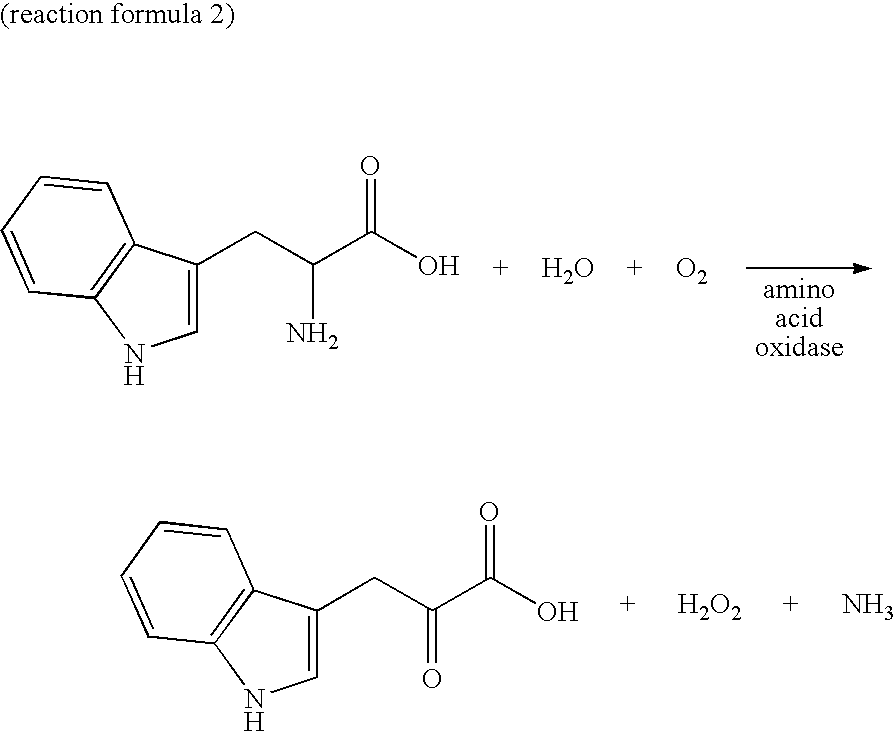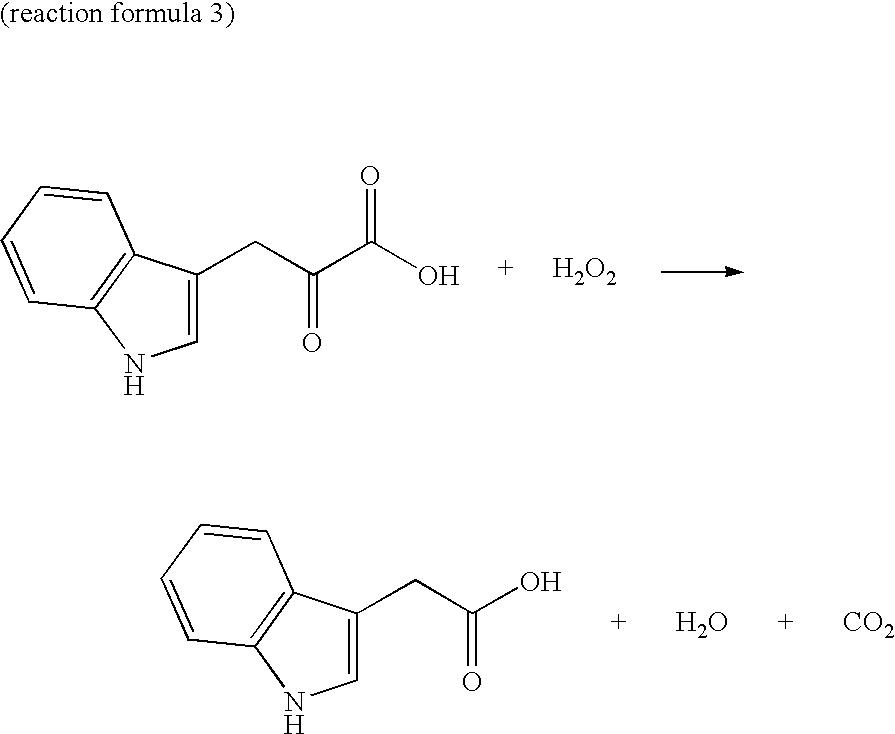Novel oxidase gene and method for producing 3-indole-pyruvic acid by utilizing the gene
a technology of pyruvate and oxidase gene, which is applied in the field of new oxidase gene and a novel method for producing 3indole-pyruvate acid by utilizing the gene, can solve the problems of high production cost, low yield, and high cost of base and pyridine aldehyde, and achieves convenient production and high yield
- Summary
- Abstract
- Description
- Claims
- Application Information
AI Technical Summary
Benefits of technology
Problems solved by technology
Method used
Image
Examples
example 1
Microorganism Producing 3-Indole-Pyruvic Acid (IPA)
[0093]A medium containing 3 g of ammonium sulfate, 1 g of monopotassium phosphate, 3 g of dipotassium phosphate, 10 mg of iron sulfate, 10 mg of manganese sulfate, 10 g of yeast extract and 10 g of peptone in 1 liter (pH 7.0) was made, 50 mL of the medium was dispensed into a 500 mL Sakaguchi flask, which was then sterilized at 120° C. for 20 minutes to use for the cultivation of microorganisms (medium 1). A slant agar medium (agar 20 g / L) containing 18 g of usual broth in 1 liter was prepared. One loopful of the microorganisms cultured on this slant agar medium at 30° C. for 24 hours was inoculated and cultured with shaking at 30° C. at 120 reciprocations / min for 16 hours. After the cultivation, microbial cells were centrifuged and prepared as the wet microbial cells.
[0094]The microorganisms were added into 20 mM Tris-HCl buffer (pH 8.0) containing 10 g / L L-Trp so that a weight of the wet microbial cells was 1% (w / v) in a total amo...
example 2
Isolation of Amino Acid Oxidase (Deaminase) Enzyme Gene Derived from Providencia rettgeri
[0095]The isolation of an amino acid oxidase (deaminase) enzyme gene will be described below. Providencia rettgeri AJ2770 strain was used as the microorganism. Escherichia coli JM109 strain was used as a host for the isolation of the gene, and pUC118 was used as a vector.
[0096]Providencia rettgeri AJ2770 strain was cultured on the agar medium containing 18 g / L of the usual broth at 30° C. for 24 hours. One loopful of the microbial cells was inoculated in the 500 mL of Sakaguchi flask in which 50 mL of the medium 1 had been placed, and cultured with shaking at 30° C.
[0097]The medium (50 mL) after the cultivation was centrifuged (8,000 rpm, 4° C., 10 minutes), and the microorganisms were collected. Chromosomal DNA was acquired from this microbial cells using QIAGEN Genomic-tip System (Qiagen) based on the method of its instructions.
[0098]The chromosomal DNA (5 μg) prepared from Providencia rettge...
example 3
Preparation of Ps_aad Expressing Strain
[0104]A promoter region of trp operon on the chromosomal DNA of Escherichia coli W3110 was amplified by PCR using oligonucleotides shown in SEQ ID NO:3 and SEQ ID NO:4 as the primers. The resulting DNA fragment was ligated to pGEM-Teasy vector (supplied from Promega). E. coli JM109 was transformed with this ligation solution, and a strain having an objective plasmid in which the trp promoter had been inserted in a direction opposite to a direction of lac promoter was selected from ampicillin resistant strains. Then, a DNA fragment containing the trp promoter obtained by treating this plasmid with EcoO109I / EcoRI was ligated to pUC19 (supplied from Takara) treated with EcoO109I / EcoRI. E. coli JM109 was transformed with this ligation solution, and a strain having an objective plasmid was selected from ampicillin resistant strains. Subsequently, a DNA fragment obtained by treating this plasmid with HindIII / PvuII was ligated to a DNA fragment contai...
PUM
| Property | Measurement | Unit |
|---|---|---|
| pH | aaaaa | aaaaa |
| concentration | aaaaa | aaaaa |
| temperature | aaaaa | aaaaa |
Abstract
Description
Claims
Application Information
 Login to View More
Login to View More - R&D
- Intellectual Property
- Life Sciences
- Materials
- Tech Scout
- Unparalleled Data Quality
- Higher Quality Content
- 60% Fewer Hallucinations
Browse by: Latest US Patents, China's latest patents, Technical Efficacy Thesaurus, Application Domain, Technology Topic, Popular Technical Reports.
© 2025 PatSnap. All rights reserved.Legal|Privacy policy|Modern Slavery Act Transparency Statement|Sitemap|About US| Contact US: help@patsnap.com



